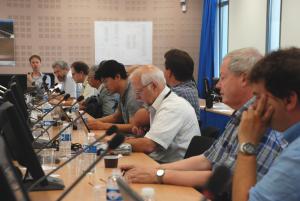Planning ITER's experimental program
10 Sep 2010
-
Wayne Houlberg, ITER Chief Scientific Officer
The Integrated Modelling Expert Group (IMEG) met at the Château for three days this week. The objective of this meeting was to review the progress and plans for the development of a suite of computational plasma physics tools to support the planning and execution of the ITER experimental program.
Applications were grouped into two categories—operations support and research support—to facilitate the identification of stakeholders and responsibilities that will be shared between the ITER Organization and the ITER Members. Support of plasma operations places the greatest demands on the modelling elements because of the interfaces with plasma control and other auxiliary systems, systematic execution for every pulse from initiation to termination, and the process of validation of proposed discharges.
These tools will be assembled, documented, and maintained by the ITER Organization and made available to all participants. Their design will involve significant coordination within the ITER Organization, primarily with the plasma control system, CODAC and diagnostics. A plasma simulator for testing the development of the plasma control system was identified as an initial target application that could be extended to support pulse validation.
The modelling elements that come under the category of plasma research support are equally important. These are generally developmental, often requiring extreme computing capabilities, and provide the basis for enhancing the fidelity of the operations support elements over the life of the ITER research program.
The primary responsibility for their development resides with the ITER Members. The research and operation tools must work together to provide a coherent basis for optimizing ITER's performance and setting the stage for a DEMO facility. This requires an infrastructure that is flexible in its hardware and software configuration to accommodate development and use by a widely distributed community. This infrastructure will be developed under a contract that is in the final stages of negotiation. Preliminary plans for tasks under this contract were summarized, and the conceptual design will be reviewed by the IMEG next spring.


